Growing Vanilla
roscheri indoors
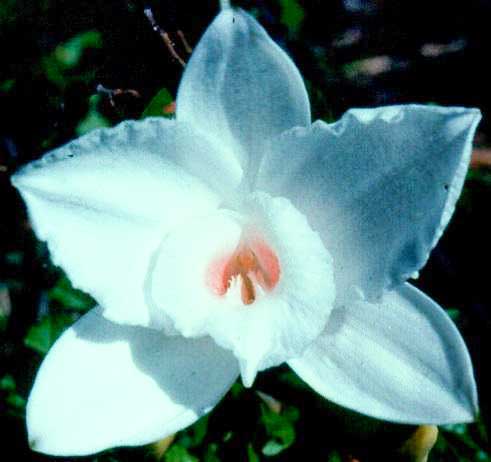
The flower of Vanilla roscheri. Photo taken by Roddy JC Ward
Vanilla roscheri is a very
attractive orchid that has a widespread range in eastern tropical
Africa, from Kenya, Tanzania and Mozambique with one officially
recorded record from South Africa. The specimens found in South Africa
were found on the shores of Lake Sibaya by Mark Ward in 1983 where
herbarium specimens were collected by him on the 05/02/1983 and again
on 01/07/1983 which were submitted to the Herbarium at the Royal
Botanic Gardens by his father Roddy Ward. I am very fortunate to have
been given a live piece of the original plant collected.
Status in South Africa
Near Threatened* D2 assessed on
the 02.09.2005 by L. von Staden and J.E. Victor
Known from one location in South Africa. Potentially threatened by subsistence agriculture, expanding informal settlements, alien plant invasion, plant collectors and traditional herbalists. The national assessment is downgraded from VU to NT as other subpopulations just across the border in Mozambique could serve as sources of propagules to South African locations
Known from one location in South Africa. Potentially threatened by subsistence agriculture, expanding informal settlements, alien plant invasion, plant collectors and traditional herbalists. The national assessment is downgraded from VU to NT as other subpopulations just across the border in Mozambique could serve as sources of propagules to South African locations
Note:
This species may be conspecific
with Vanilla phalaenopsis Reichenbach f. from the Seychelles and with
Vanilla madagascariensis Rolfe from Madagascar, if so, Vanilla
phalaenopsis would be the correct name.
Description
Vanilla roscheri is a leafless,
terete liana-like climber with green succulent stems up to c. 1 cm in
diameter and short roots at the nodes. Small brownish vestigial leaves
up to 3 cm long are sometimes present at the nodes.
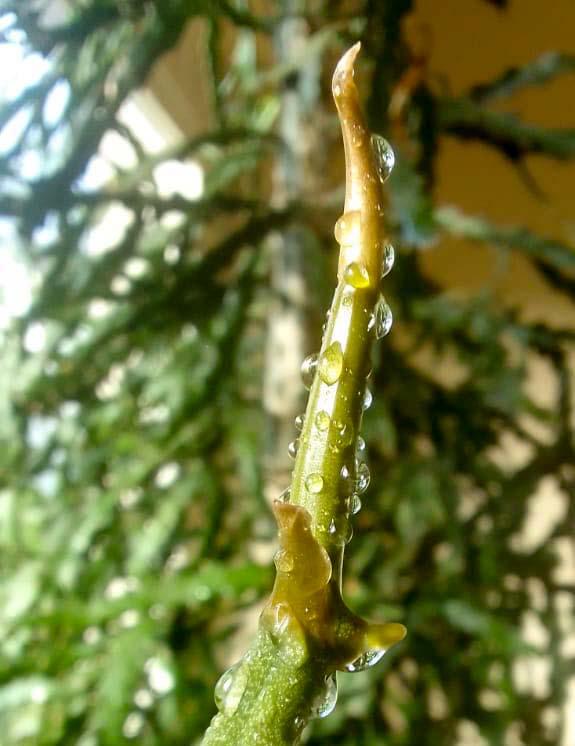
Here the vestigial leaves are
clearly seen on Vanilla roscheri grown in my lounge from the original
specimen discovered and collected by Mark Ward at lake Sibaya.
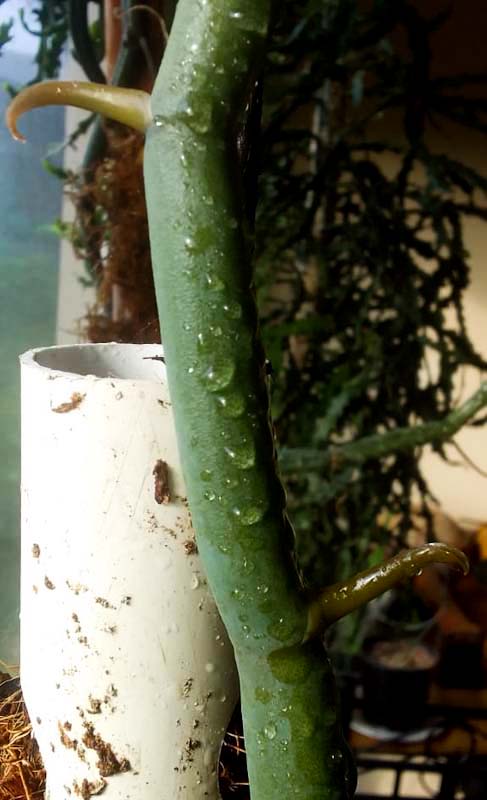
Here again vestigial leaves are clearly seen on a Vanilla roscheri from
Inhambane in Mozambique.

A very distinguishing feature
of Vanilla roscheri are two shallow channels on each side running the
length of the vine between the internodes which are up to 15 cm long.
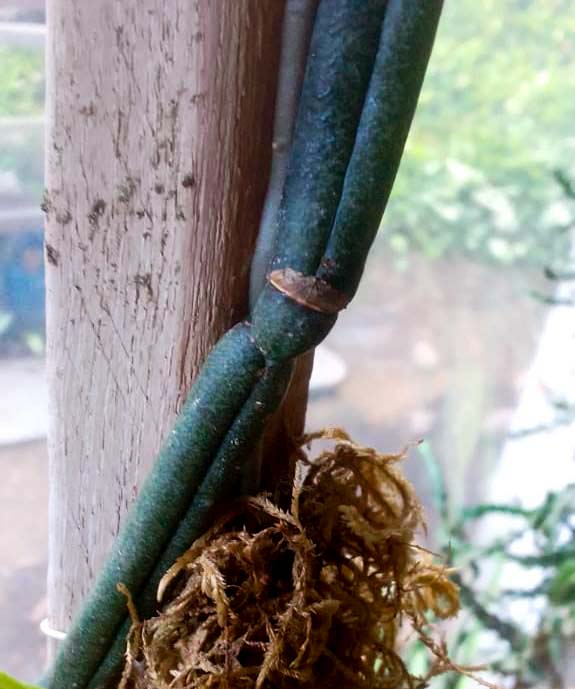

Here the two shallow channels on each side the vine of Vanilla roscheri grown in my lounge from the original specimen discovered and collected by mark Ward can clearly be seen.
The inflorescence is
many-flowered, up to 30 cm long, terminal or at the nodes. Flowers are
large and showy, up to 15 cm in diameter, white, more or less flushed
with pink, strongly and sweetly scented. Lip funnel-shaped, often
salmon-pink or yellowish in the throat. Capsule up to 17.5 cm long.
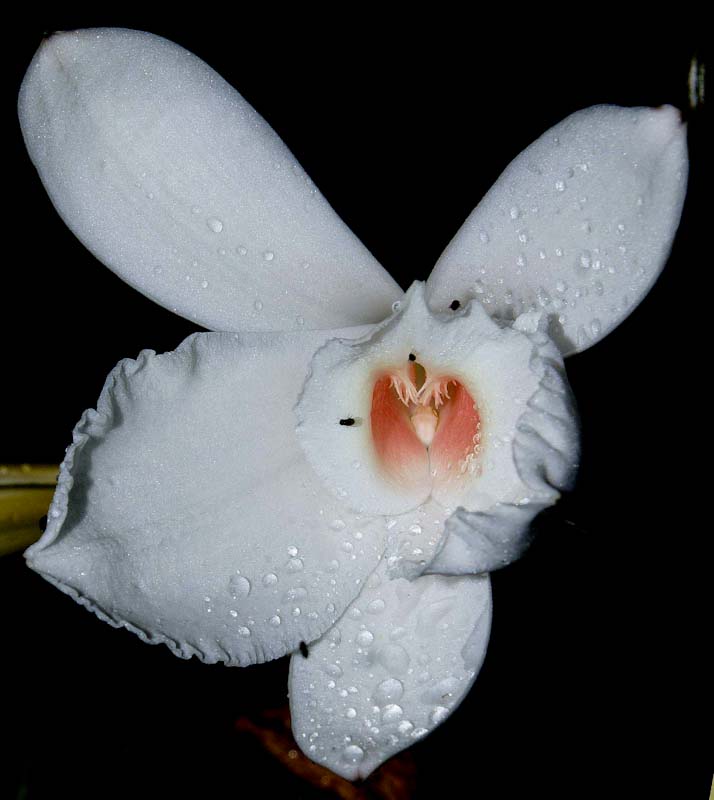
Seed pods of Vanilla roscheri growing on Erythrina latissima photo below was taken by Roddy JC Ward
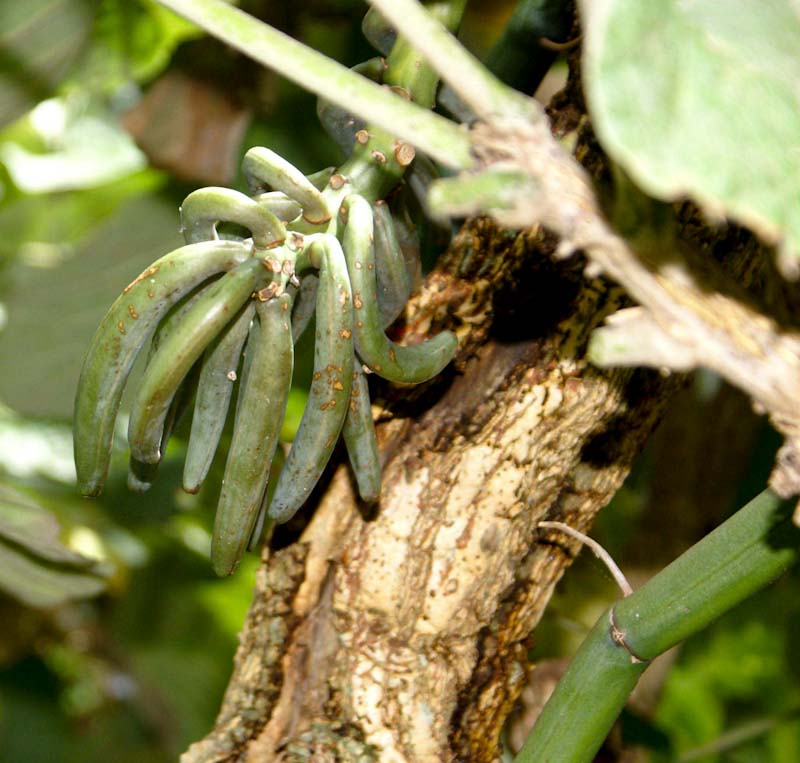
Habitat
Vanilla roscheri are found
growing where it is hot and humid near to the coast in mangrove forest,
evergreen scrub, coastal bush and forest, and in grassy fields with
scattered trees at elevations in South Africa 1-100 m, elsewhere at
elevations of 0 up to 1050 meters
Cultivation
Vanilla roscheri which is easy
to grow must have warm to hot temperatures with high humidity to grow
well. The lower part of the plant and the roots can be in shade,
however the top of the plant needs to be in partial shade to full sun
for them to flower. My plants that are growing extremely well inside
get a few hours of full sun in the morning in the hot and humid summer
months and only bright light in the winter months when they are
dormant. On hot and humid summer days I ensure good ventilation and
have a fan running during the daytime to provide good air movement
around them at all times.
Vanilla roscheri require a
large pot filled with a very loose well drained open growing medium.
They require a pole to provide to provide opportunity for climbing. I
grow mine a growing medium consisting course river sand, to which
I add a little very coarse sieved well drained leaf mould containing
many sticks and partially decomposed leaves to which I add some crushed
egg shells, a little charcoal and perlite. It is essential to add good
drainage and airholes on the sides at the base of the pot or to place
the pot on feet. The plants must be allowed to dry out somewhat before
watering. Reduce the watering in the cooler months. They need good air
movement and respond well to misting. They respond well to a regular
addition of a very weak solution of liquid fertiliser.
Flush out the pot well with clean water from time to time to avoid salt build up.
Fertilizing
I feed frequently using a very dilute amount of a variety of plant feeds such as
EasyGro™Flower and Fruit
is a 3:1:6(46) water soluble fertilizer, high in concentrations of Potassium ideally suitable for crops during the flowering and fruiting stages.
SEAGRO™ Bio-Fertiliser
Bionutrient with Enhanced Amino Acids. A fish emulsion rich in micro & macro elements and 17 amino acids. Seagro is used as organic fertilizer in agricultural practices for maintenance of crop health. Seagro has a remarkable impact on crop quality as well as yield through the activation of key metabolic processes. Seagro serves not only as a nutrition and stress reliever, but also plays an important role in the vitality of the microbial population in the soil.
Nitrosol Original Biological Fertiliser
is the original formulation developed by Dr. Peter Kauzal, a veterinary surgeon, from ruminant blood and bone. Nitrosol Original has a balanced NPK of 11.5.7 plus trace elements and minerals and recommended for use in all horticultural crops and home garden.
Fulvic acid.
Fulvic acid is group of chemicals formed when plants and animals break down. It is found in the humus (organic matter) part of soil and peat, and is also found in streams and lakes.
Fulvic acid benefits of increases root respiration and formation,enhance plant growth and yield. Humic fulvic acid can enhances pH buffering capacity, enhances photosynthesis and respiration, increases cationic exchange.
Brings about an improvement in the transport of nutrients, making them available in the areas of need. Increases the synthesis of proteins and nucleic acids, which will facilitate the action of enzymes formed with some amino acids and micro-nutrients.
Tea
I also feed and mist regularly with a week solution of both black tea and rooibos tea which appears to be very beneficial to both my ferns as well as my orchid plants.
Although Vanilla roscheri is probably rather salt tollerant as it grows in coastal dune scrub right on the seashore at Inhambane in Mozambique, I periodically flush out the pots with clean tap water to remove any buildup of salts or other harmful substances of decay in the growing medium.
Propagation
Vanilla roscheri grows very easily from large cuttings taken just before they initiate new growth in summer.
Flush out the pot well with clean water from time to time to avoid salt build up.
Fertilizing
I feed frequently using a very dilute amount of a variety of plant feeds such as
EasyGro™Flower and Fruit
is a 3:1:6(46) water soluble fertilizer, high in concentrations of Potassium ideally suitable for crops during the flowering and fruiting stages.
SEAGRO™ Bio-Fertiliser
Bionutrient with Enhanced Amino Acids. A fish emulsion rich in micro & macro elements and 17 amino acids. Seagro is used as organic fertilizer in agricultural practices for maintenance of crop health. Seagro has a remarkable impact on crop quality as well as yield through the activation of key metabolic processes. Seagro serves not only as a nutrition and stress reliever, but also plays an important role in the vitality of the microbial population in the soil.
Nitrosol Original Biological Fertiliser
is the original formulation developed by Dr. Peter Kauzal, a veterinary surgeon, from ruminant blood and bone. Nitrosol Original has a balanced NPK of 11.5.7 plus trace elements and minerals and recommended for use in all horticultural crops and home garden.
Fulvic acid.
Fulvic acid is group of chemicals formed when plants and animals break down. It is found in the humus (organic matter) part of soil and peat, and is also found in streams and lakes.
Fulvic acid benefits of increases root respiration and formation,enhance plant growth and yield. Humic fulvic acid can enhances pH buffering capacity, enhances photosynthesis and respiration, increases cationic exchange.
Brings about an improvement in the transport of nutrients, making them available in the areas of need. Increases the synthesis of proteins and nucleic acids, which will facilitate the action of enzymes formed with some amino acids and micro-nutrients.
Tea
I also feed and mist regularly with a week solution of both black tea and rooibos tea which appears to be very beneficial to both my ferns as well as my orchid plants.
Although Vanilla roscheri is probably rather salt tollerant as it grows in coastal dune scrub right on the seashore at Inhambane in Mozambique, I periodically flush out the pots with clean tap water to remove any buildup of salts or other harmful substances of decay in the growing medium.
Propagation
Vanilla roscheri grows very easily from large cuttings taken just before they initiate new growth in summer.
Pest control
Vanilla roscheri can be prone
to scale insect attack when grown inside. To prevent scale insect
attack I use Efekto
Granules Plus active ingredient Imidacloprid (chloro-nicotinyl)
which is taken up by the roots and evenly
distributed to the entire plant which is highly effective against most
sucking insects and provides long term control between 4 – 8 weeks.
Efekto Granules Plus is a Neonicotinoid a class of neuro-active
insecticides chemically similar to nicotine compared to organophosphate
and carbamate insecticides, neonicotinoids are less toxic to birds and
mammals, and therefore very safe to use within the home environment.
http://apps.kew.org/herbcat/detailsQuery.do?barcode=K000392070
https://orchids.fandom.com/wiki/Vanilla_roscheri
https://www.mozambiqueflora.com/speciesdata/species.php?species_id=180910
http://redlist.sanbi.org/species.php?species=2771-1
Article written by Michael Hickman from data collected from the websites listed above a
as well as from own experience growing this orchid both indoors and out doors.
09.03.21 updated 30.01.23
| Home |
Contact | |
| Green Roof |
Rehabilitation |
|
| Landscaping |
Weed |
|
 |
 |